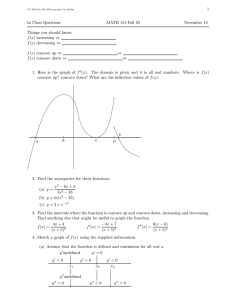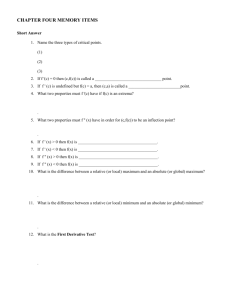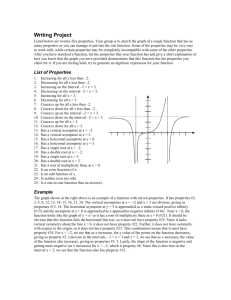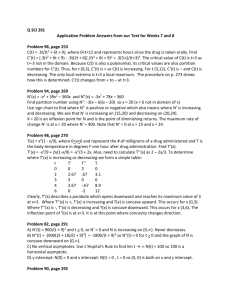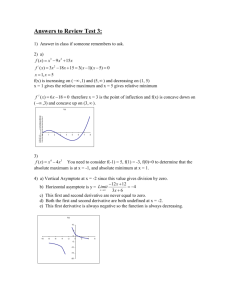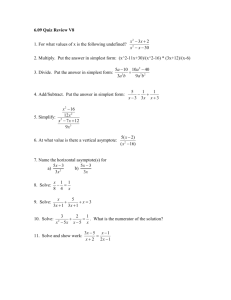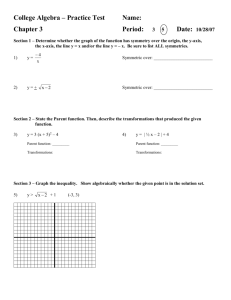1 In Class Questions MATH 151-Fall 02 November 14
advertisement
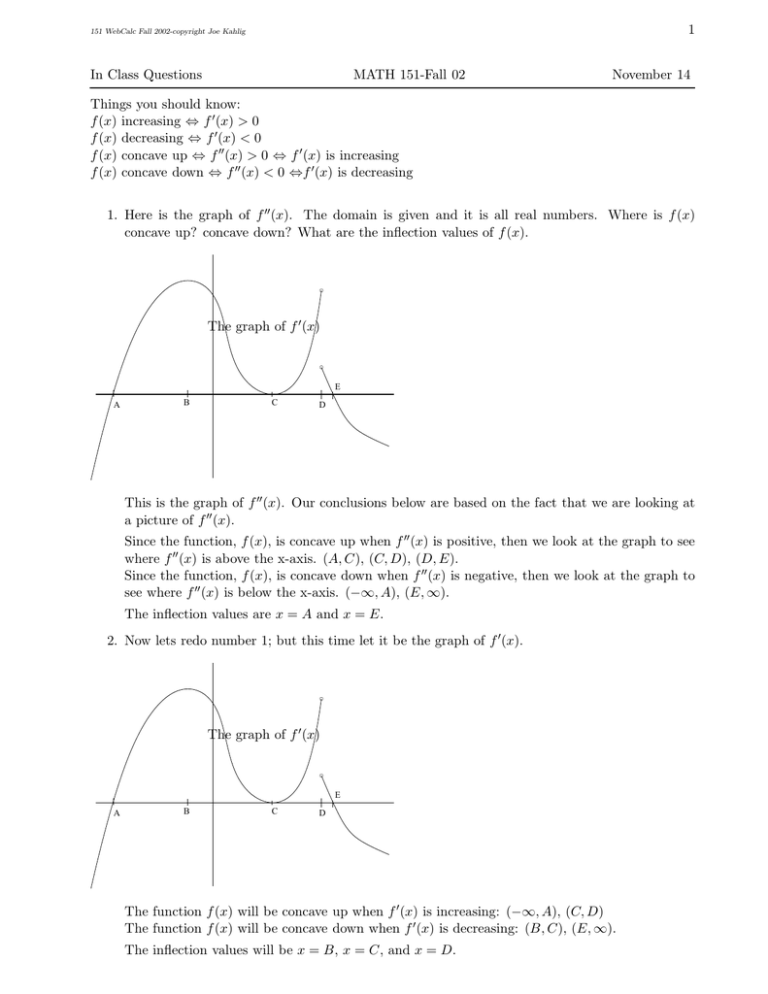
1 151 WebCalc Fall 2002-copyright Joe Kahlig In Class Questions MATH 151-Fall 02 November 14 Things you should know: f (x) increasing ⇔ f 0 (x) > 0 f (x) decreasing ⇔ f 0 (x) < 0 f (x) concave up ⇔ f 00 (x) > 0 ⇔ f 0 (x) is increasing f (x) concave down ⇔ f 00 (x) < 0 ⇔f 0 (x) is decreasing 1. Here is the graph of f 00 (x). The domain is given and it is all real numbers. Where is f (x) concave up? concave down? What are the inflection values of f (x). The graph of f 0 (x) E A B C D This is the graph of f 00 (x). Our conclusions below are based on the fact that we are looking at a picture of f 00 (x). Since the function, f (x), is concave up when f 00 (x) is positive, then we look at the graph to see where f 00 (x) is above the x-axis. (A, C), (C, D), (D, E). Since the function, f (x), is concave down when f 00 (x) is negative, then we look at the graph to see where f 00 (x) is below the x-axis. (−∞, A), (E, ∞). The inflection values are x = A and x = E. 2. Now lets redo number 1; but this time let it be the graph of f 0 (x). The graph of f 0 (x) E A B C D The function f (x) will be concave up when f 0 (x) is increasing: (−∞, A), (C, D) The function f (x) will be concave down when f 0 (x) is decreasing: (B, C), (E, ∞). The inflection values will be x = B, x = C, and x = D. 2 151 WebCalc Fall 2002-copyright Joe Kahlig 3. Find the asymptotes for these functions. For part A look at the Asymptote handout to see the shortcut. x2 − 6x + 8 3x2 − 48 Horizontal asymptote: y = 13 Vertical asymptote: x = −4 (a) y = (b) y = ln(x2 − 25) if you take the limit at x → ∞ or x → −∞, you get an answer of ∞. Thus there are no horizontal asymptotes. To find the vertical asymptote, find the number that you would plug in to get ln 0. That value of x will be a vertical asymptote. Horizontal asymptote: none Vertical asymptote: x = −5, x = 5 2 (c) y = 3 + e−x This function is never undefined, so no vertical asymptote. If you take the limit as x → ∞ or x → −∞, you get an answer of 3. Horizontal asymptote: y = 3 Vertical asymptote: none 4. Find the intervals where the function is concave up and concave down, increasing and decreasing. Find anything else that might be useful to graph the function. 3x + 4 −3x + 7 6(x − 6) f (x) = f 0 (x) = f 00 (x) = 2 3 (x + 5) (x + 5) (x + 5)4 HA: y = 0 VA: x = −5 Setting the first derivative equal to zero and solving for x gives x = 73 . Note x = −5 is not a critical value since it is not in the domain. From the sign chart listed below, we can find the intervals of increasing and decreasing. inc −5, 73 dec (−∞, −5), 7 3, ∞ − y 7 3 There is a rel max at x = There looks to be a rel min at x = −5. However, that value is not a critical value so it can not be a relative min. −7 y − + −5 − 7/3 0 5 + − −5 0 6 10 Taking the second derivative and setting it equal to zero gives a possible inflection values of x = 6. Note x = −5 is not a possible inflection value since it is not in the domain. From the sign chart listed above, we can find the intervals of concavity. concave up: (6, ∞) Concave down: (−∞, −5), (−5, 6) The graph of the function is 5. Sketch a graph of f (x) using the supplied information. (a) Assume that the function is defined and continuous for all real x. 3 151 WebCalc Fall 2002-copyright Joe Kahlig −5 6 y 0 undefined y0 < 0 y0 = 0 y0 > 0 x1 x2 y0 < 0 x3 y 00 undefined y 00 > 0 y 00 < 0 y 00 > 0 This is a rough sketch of the function. Nothing in the problem says where the function should be placed on the graph, so there are many possible correct answers. x1 x2 x3 (b) x-intercept of 0, vertical asymptote: x = −5 and x = 5 f 0 (−2) = f 0 (2) = f 0 (7) = 0, lim f (x) = 0, lim f (x) = 3 x→∞ x→−∞ f 0 (x) < 0 on (−∞, −5), (−5, −2) and (2, 5) f 0 (x) > 0 on (−2, 2) and (5, ∞) f 00 (x) > 0 on (−5, 0) and (7, 9) f 00 (x) < 0 on (−∞, −5), (0, 5), (5, 7) and (9, ∞) −2 −5 7 2 5 9
